Find my mini reviews for foster care and adoption themed children’s books here. Scroll down to look for a specific book, and check out @adoption.books for more detailed reviews of these books as I post them there. I DO NOT recommend all these books. As an adoptive parent, I understand the great complexity of adoption- some of these books don’t address that well. These little reviews are to help you decide what discussions you want to have about adoption with your children. Without bashing the authors, I try to be honest about what I do and don’t like about each book.
*The books we recommend have links to purchase on amazon.ca if you click on the title of the book. Purchasing through these links helps me to keep doing reviews for your family, too.
Foster Themed Children’s Books:
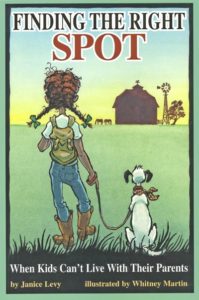 Finding the Right Spot: When Kids Can’t Live With Their Parents, written Janice Levy, illustrated by Whitney Martin –This is a a sweet book written from a child’s perspective, kind of just explaining the child’s life and some thoughts she has about her mom, living in a foster home, and what she hopes the future holds. The child lives with a foster mom. This doesn’t attempt to give any answers about life for foster care, but it simply allows the child’s thoughts to be expressed. I love its simplicity and honesty.
Finding the Right Spot: When Kids Can’t Live With Their Parents, written Janice Levy, illustrated by Whitney Martin –This is a a sweet book written from a child’s perspective, kind of just explaining the child’s life and some thoughts she has about her mom, living in a foster home, and what she hopes the future holds. The child lives with a foster mom. This doesn’t attempt to give any answers about life for foster care, but it simply allows the child’s thoughts to be expressed. I love its simplicity and honesty.
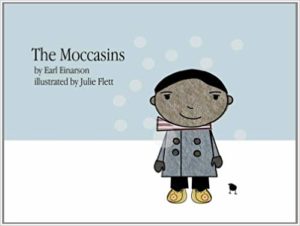 The Moccasins, written by Earl Einarson, illustrated by Julie Flett – This is a child centric book written by a former foster youth. The book is simple, sweet story from a boy’s perspective about special memories in his foster home. It features an Aboriginal child and celebrates aboriginal culture.
The Moccasins, written by Earl Einarson, illustrated by Julie Flett – This is a child centric book written by a former foster youth. The book is simple, sweet story from a boy’s perspective about special memories in his foster home. It features an Aboriginal child and celebrates aboriginal culture.
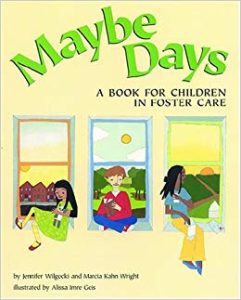 Maybe Days: A Book for Children In Foster Care, written by Jennifer Wilgoki and Marcia Kahn Wright, illustrated by Alissa Imre Geis – This book acknowledges the frustration and complexity of living life in foster care. It gives simple explanations for different roles of people involved in foster care. A great tool for foster families.
Maybe Days: A Book for Children In Foster Care, written by Jennifer Wilgoki and Marcia Kahn Wright, illustrated by Alissa Imre Geis – This book acknowledges the frustration and complexity of living life in foster care. It gives simple explanations for different roles of people involved in foster care. A great tool for foster families.
.
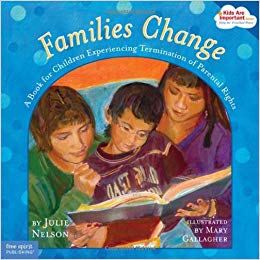 Families Change: A Book for Children Experiencing Termination of Parental Rights, written by Julie Nelson, illustrated by Mary Gallagher -This book is exactly as the title describes. It does a beautiful job with simple, repetitive language, which we know is so powerful for children with special needs and/or who have experienced trauma. Multiracial characters are featured in various family groups. This book embraces all the complexity of adoption with beautiful straightforwardness.
Families Change: A Book for Children Experiencing Termination of Parental Rights, written by Julie Nelson, illustrated by Mary Gallagher -This book is exactly as the title describes. It does a beautiful job with simple, repetitive language, which we know is so powerful for children with special needs and/or who have experienced trauma. Multiracial characters are featured in various family groups. This book embraces all the complexity of adoption with beautiful straightforwardness.
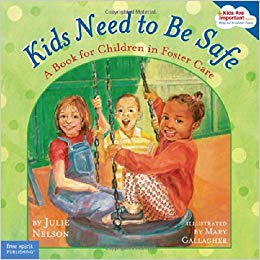 Kids Need to Be Safe: A Book for Children in Foster Care, written by Julie Nelson, illustrated by Mary Gallagher – This is a beautiful book with straightforward truths about a child’s inherent value and need for safety. This book uses simple, repetitive, inclusive language. Multiracial children, adults and family groups are shown throughout the book. It applies to children who have not lived in foster care, but perhaps their parents chose an adoption plan at their birth to keep them safe.
Kids Need to Be Safe: A Book for Children in Foster Care, written by Julie Nelson, illustrated by Mary Gallagher – This is a beautiful book with straightforward truths about a child’s inherent value and need for safety. This book uses simple, repetitive, inclusive language. Multiracial children, adults and family groups are shown throughout the book. It applies to children who have not lived in foster care, but perhaps their parents chose an adoption plan at their birth to keep them safe.
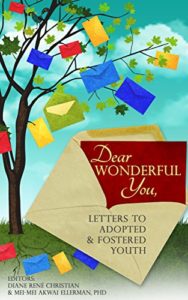 Dear Wonderful You: Letters To Adopted And Foster Youth, edited by Diane Rene Christian and Mei-Mei Akwai Elderman, PhD – This is an excellent adoptee centric resource. This books includes entries from various adoptees and former foster youth in a wide variety of genres. Recommended for teens and adult
Dear Wonderful You: Letters To Adopted And Foster Youth, edited by Diane Rene Christian and Mei-Mei Akwai Elderman, PhD – This is an excellent adoptee centric resource. This books includes entries from various adoptees and former foster youth in a wide variety of genres. Recommended for teens and adult
readers.
______________________________________________________________________________
Adoption Themed Children’s Books:
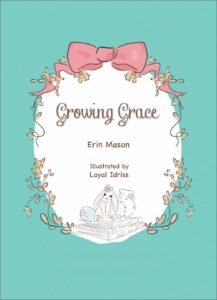 Growing Grace, written by Erin Mason, illustrated by Layal Idriss. This gorgeous book is written by a birthmom from the perspective of a mom deciding what to do in the event of an unplanned pregnancy. This book captures the complexity of adoption so beautifully, expressing the sadness, loss, and fear of the mom in a child appropriate manner. Features a white mom and baby.
Growing Grace, written by Erin Mason, illustrated by Layal Idriss. This gorgeous book is written by a birthmom from the perspective of a mom deciding what to do in the event of an unplanned pregnancy. This book captures the complexity of adoption so beautifully, expressing the sadness, loss, and fear of the mom in a child appropriate manner. Features a white mom and baby.
.
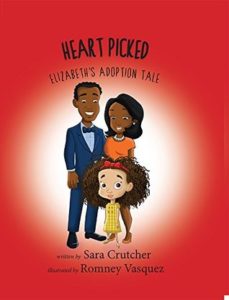 Heart Picked, written by Sara Crutcher, illustrated by Romney Vasquez. This is a simple book, written by an adult adoptee about a elementary school aged child and her worries about what her friends will think when they see what she looks different than her parents. It does not address biological family, it only highlights the similarities between the adoptee and her adoptive parents. Neither the illustrations or dialogue are exceptional, but the fact that it’s written by an adoptee holds value to me. The book features a black mom and dad and a biracial daughter.
Heart Picked, written by Sara Crutcher, illustrated by Romney Vasquez. This is a simple book, written by an adult adoptee about a elementary school aged child and her worries about what her friends will think when they see what she looks different than her parents. It does not address biological family, it only highlights the similarities between the adoptee and her adoptive parents. Neither the illustrations or dialogue are exceptional, but the fact that it’s written by an adoptee holds value to me. The book features a black mom and dad and a biracial daughter.
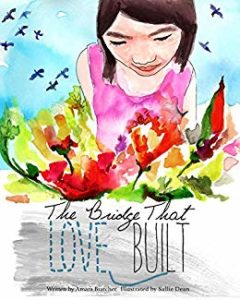 The Bridge That Love Built, written by Amara Bratcher, illustrated by Sallie Dean- written by an adoptive aunt, and illustrated by an adoptive mom, this is a Christian faith based book that talks about the sovereignty of God in the unknowns of adoption. Specifically for older child adoption, this book talks about both the needs of the adoptee and the desires of the adoptive family. Features a Chinese adoptee.
The Bridge That Love Built, written by Amara Bratcher, illustrated by Sallie Dean- written by an adoptive aunt, and illustrated by an adoptive mom, this is a Christian faith based book that talks about the sovereignty of God in the unknowns of adoption. Specifically for older child adoption, this book talks about both the needs of the adoptee and the desires of the adoptive family. Features a Chinese adoptee.
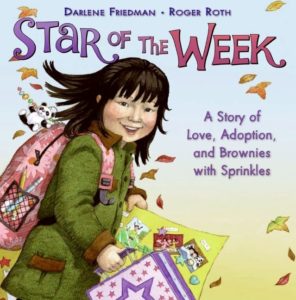 Star Of The Week: A Story of Love, Adoption & Brownies With Sprinkles – Darlene Friedman -Written by an adoptive mom, this book details a kindergarten student making a poster about their life and how being an adoptee makes their life special and complex. Features a Chinese adoptee.
Star Of The Week: A Story of Love, Adoption & Brownies With Sprinkles – Darlene Friedman -Written by an adoptive mom, this book details a kindergarten student making a poster about their life and how being an adoptee makes their life special and complex. Features a Chinese adoptee.
.
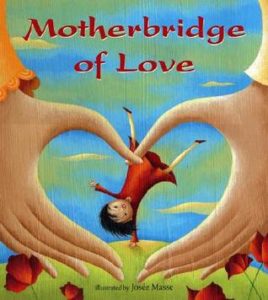 Motherbridge of Love, written anonymously, illustrated by Josée Masse – This book is a poem written by an anonymous mom-by-adoption. It describes the connection of two mothers- the birthmom and the adoptive mom, and the link the child has with each of them. The child and birthmom in this story are Asian and the adoptive mom is white. There is a Chinese translation of the poem in the front cover. This book celebrates both biology and adoption, and highlights the complexities found therein.
Motherbridge of Love, written anonymously, illustrated by Josée Masse – This book is a poem written by an anonymous mom-by-adoption. It describes the connection of two mothers- the birthmom and the adoptive mom, and the link the child has with each of them. The child and birthmom in this story are Asian and the adoptive mom is white. There is a Chinese translation of the poem in the front cover. This book celebrates both biology and adoption, and highlights the complexities found therein.
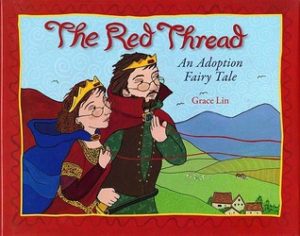 The Red Thread: An Adoption Fairytale, written and illustrated by Grace Lin – Written by a Chinese author who is not part of the adoption triad. Gives a narrative to the Chinese proverb that an invisible thread connects all people who belong together. It is very adoptive parent centric, focusing on the connection of the adoptive family, their longing for something missing, and the lengths they go to in order to adopt a child. It does not acknowledge the connection to the biological family, which remains even after the child moves to a new home with their adoptive family. This is a crucial element in all adoption themed literature for kids. Features an Asian child and white parents.
The Red Thread: An Adoption Fairytale, written and illustrated by Grace Lin – Written by a Chinese author who is not part of the adoption triad. Gives a narrative to the Chinese proverb that an invisible thread connects all people who belong together. It is very adoptive parent centric, focusing on the connection of the adoptive family, their longing for something missing, and the lengths they go to in order to adopt a child. It does not acknowledge the connection to the biological family, which remains even after the child moves to a new home with their adoptive family. This is a crucial element in all adoption themed literature for kids. Features an Asian child and white parents.
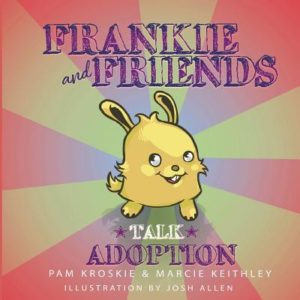 Frankie And Friends Talk Adoption, written by Pam Kroskie and Marcie Keithley, illustrated by Josh Allen – This book is written by an adoptee and a first mom. It is not a story, but rather each page addresses an issue that an adoptee might have big feelings or questions about. It validates any feelings the young adoptee may have and encourages conversation though questions. This a fantastic tool for families to have open conversations in which all feelings are allowed.
Frankie And Friends Talk Adoption, written by Pam Kroskie and Marcie Keithley, illustrated by Josh Allen – This book is written by an adoptee and a first mom. It is not a story, but rather each page addresses an issue that an adoptee might have big feelings or questions about. It validates any feelings the young adoptee may have and encourages conversation though questions. This a fantastic tool for families to have open conversations in which all feelings are allowed.
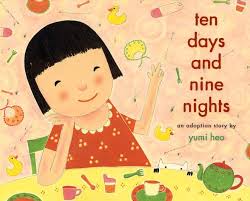 Ten Days and Nine Nights: An Adoption Story, written and illustrated by Yumi Heo – Written by a Korean author who is not a member of the adoption triad. Talks about a girl waiting for a new sister to come home from Korea with her mom. There is no mention of the new adoptee’s birth family. It appears that the new baby is being adopted by a family who looks like her.
Ten Days and Nine Nights: An Adoption Story, written and illustrated by Yumi Heo – Written by a Korean author who is not a member of the adoption triad. Talks about a girl waiting for a new sister to come home from Korea with her mom. There is no mention of the new adoptee’s birth family. It appears that the new baby is being adopted by a family who looks like her.
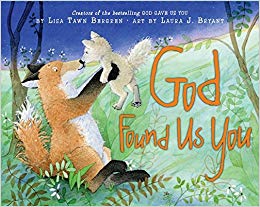 God Found Us You, written by Lisa Tawn Bergren, illustrated by Laura J. Bryant. This is an AP centric book written about the joy of finally finding a child for the mom’s family. It is focused on the fox mother sharing her deep desire for a child, waiting for her child, and her joy at finally having her kit. This book is meant to assure the child of the love of the adopted parent. There is a mention of the birth mother and how she must have prayed for her child and his future family.
God Found Us You, written by Lisa Tawn Bergren, illustrated by Laura J. Bryant. This is an AP centric book written about the joy of finally finding a child for the mom’s family. It is focused on the fox mother sharing her deep desire for a child, waiting for her child, and her joy at finally having her kit. This book is meant to assure the child of the love of the adopted parent. There is a mention of the birth mother and how she must have prayed for her child and his future family.
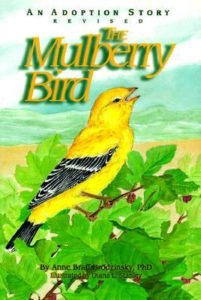 The Mulberry Bird: an Adoption Story written by Anne Braff Brodsinsky PhD, illustrated by Diana L. Stanley, revised and republished 1996. This book is written by a psychologist and adoption researcher who is also an adoptive parent, but it is centered on a birthmom- who in this book appears as a bird. It is a story about a bird who is alone and without help when she has her first chick, and due to circumstances does not feel she can care for and keep her chick safe. She finds adoptive parents for her chick. This book would be a good conversation starter for families to talk about some of the specific details of the reasons their children were adopted.
The Mulberry Bird: an Adoption Story written by Anne Braff Brodsinsky PhD, illustrated by Diana L. Stanley, revised and republished 1996. This book is written by a psychologist and adoption researcher who is also an adoptive parent, but it is centered on a birthmom- who in this book appears as a bird. It is a story about a bird who is alone and without help when she has her first chick, and due to circumstances does not feel she can care for and keep her chick safe. She finds adoptive parents for her chick. This book would be a good conversation starter for families to talk about some of the specific details of the reasons their children were adopted.
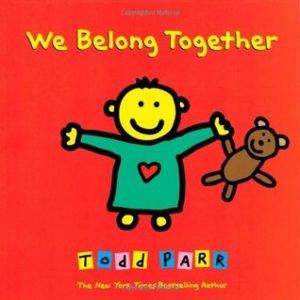 We Belong Together, written and illustrated by Todd Parr – This book is not adoption specific, but is meant to bring attention to many different types of families (including those with pets). It is a very simplistic, stating that children need something so they are adopted by a family that can give them that thing. We don’t appreciate the simplicity of this book, it is unhelpful in a family trying to navigate the complexity of adoption. It also suggests that the child’s first family did not love and hug them, and that a child’s needs are incredibly basic. Features people with all different colours of skin and hair and in various family groupings.
We Belong Together, written and illustrated by Todd Parr – This book is not adoption specific, but is meant to bring attention to many different types of families (including those with pets). It is a very simplistic, stating that children need something so they are adopted by a family that can give them that thing. We don’t appreciate the simplicity of this book, it is unhelpful in a family trying to navigate the complexity of adoption. It also suggests that the child’s first family did not love and hug them, and that a child’s needs are incredibly basic. Features people with all different colours of skin and hair and in various family groupings.
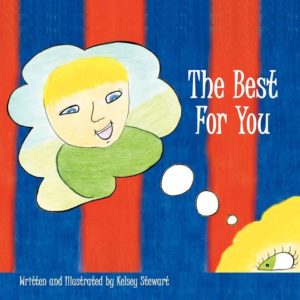 The Best for You, written and illustrated by Kelsey Stewart. This is a book written and illustrated by a birthmom detailing her thought process as she makes an adoption plan for her unborn baby, why she chose adoption and what it means to her. beautifully written, however, this is self-published and illustrated, so the art is not very enjoyable.
The Best for You, written and illustrated by Kelsey Stewart. This is a book written and illustrated by a birthmom detailing her thought process as she makes an adoption plan for her unborn baby, why she chose adoption and what it means to her. beautifully written, however, this is self-published and illustrated, so the art is not very enjoyable.
Who’s Your Daddy: Discovering The Awesomest Daddy Ever, written by Lisa and Missy Harper, illustrated by Olivia Duchess. When transracial, international adoptee Missy wonders who and where her dad is, her single mother helps her to understand God’s role as her heavenly father, the blessings and limitations of a “skin daddy”. This book is good for children understanding and discussing diverse family structure, broken families and the importance of a relationship with our heavenly Father, God.
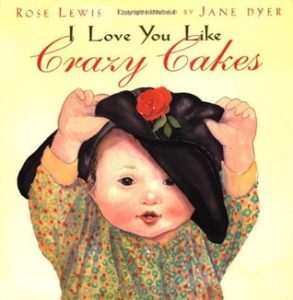 I Love You Like Crazy Cakes and sequel Every Year On Your Birthday, both written by Rose Lewis and illustrated by Jane Dyer – The first book is an AP centric account of a single mother wishing for, adopting and bringing home a baby girl from China. It is focused on the mother, the excitement of the new child meeting new family members, and has a brief mention of the birthmother and hoping she knows her baby girl is deeply loved and safe. The second book is a continuation of the first, but is much more focused on the Chinese adoptee. It details activities for each of her first 5 birthdays, as well as some introspective thoughts that the adoptive mom has about her child’s early life, her birth culture, and her first family.
I Love You Like Crazy Cakes and sequel Every Year On Your Birthday, both written by Rose Lewis and illustrated by Jane Dyer – The first book is an AP centric account of a single mother wishing for, adopting and bringing home a baby girl from China. It is focused on the mother, the excitement of the new child meeting new family members, and has a brief mention of the birthmother and hoping she knows her baby girl is deeply loved and safe. The second book is a continuation of the first, but is much more focused on the Chinese adoptee. It details activities for each of her first 5 birthdays, as well as some introspective thoughts that the adoptive mom has about her child’s early life, her birth culture, and her first family. 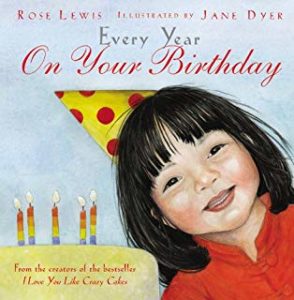 Of the two, we most highly recommend the second book (we don’t love the first one since it is so AP centric and shares overwhelming homecoming activities that we don’t recommend), as it centers much more on the adoptee while addressing the complexity of adoption well.
Of the two, we most highly recommend the second book (we don’t love the first one since it is so AP centric and shares overwhelming homecoming activities that we don’t recommend), as it centers much more on the adoptee while addressing the complexity of adoption well.
.
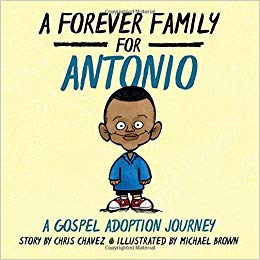 A Forever Family For Antonio: A Gospel Adoption Journey, written by Chris Chavez, illustrated by Michael Brown – This is a foster care and adoption themed book from a Christian faith perspective. It is written by an adoptive father about a boy looking for and finding his forever family. This book speaks to the causes of children being in foster care, the loneliness of children waiting for permanence and the sovereignty of God in a world broken by sin. It does not give a lot of good answers for the complexity of adoption, but can be a good place to start and continue conversations about adoption loss.
A Forever Family For Antonio: A Gospel Adoption Journey, written by Chris Chavez, illustrated by Michael Brown – This is a foster care and adoption themed book from a Christian faith perspective. It is written by an adoptive father about a boy looking for and finding his forever family. This book speaks to the causes of children being in foster care, the loneliness of children waiting for permanence and the sovereignty of God in a world broken by sin. It does not give a lot of good answers for the complexity of adoption, but can be a good place to start and continue conversations about adoption loss.
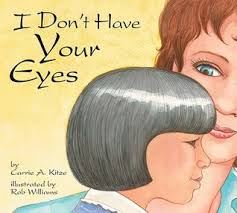 I Don’t Have Your Eyes, written by Carrie A Kitze and illustrated by Rob Williams. This is a simplistic book about similarities and difference between adoptees and their families. I like that this book opens up conversations about differences in people. These should be celebrated instead of ignored. Our children need us to acknowledge and enjoy their uniqueness. It is a little too simple, and the art is not my favorite. Features parents and children of various ages and ethnicities.
I Don’t Have Your Eyes, written by Carrie A Kitze and illustrated by Rob Williams. This is a simplistic book about similarities and difference between adoptees and their families. I like that this book opens up conversations about differences in people. These should be celebrated instead of ignored. Our children need us to acknowledge and enjoy their uniqueness. It is a little too simple, and the art is not my favorite. Features parents and children of various ages and ethnicities.
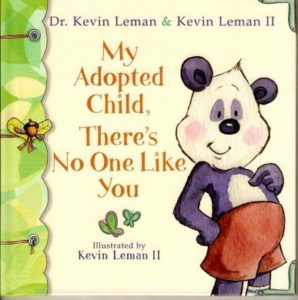 My Adopted Child, There’s No One Like You – Dr Kevin Leman and Kevin Leman II, illustrated by Kevin Leman II. This book comes at adoption from a very traditional view point and does not acknowledge the complexity of adoption or the adoptees feelings well. It addresses the difficulty of making a family tree when one is adopted, which we like. But we do not deny our children’s feelings of sadness or confusion about adoption with simple explanations. We also don’t expect our children to lead on adoption discussions, both of which seem to be the case in this book. This was a gift to our family, and we do not recommend it since we change the language whenever we read it. Features a panda son and brown bear parents/grandparents.
My Adopted Child, There’s No One Like You – Dr Kevin Leman and Kevin Leman II, illustrated by Kevin Leman II. This book comes at adoption from a very traditional view point and does not acknowledge the complexity of adoption or the adoptees feelings well. It addresses the difficulty of making a family tree when one is adopted, which we like. But we do not deny our children’s feelings of sadness or confusion about adoption with simple explanations. We also don’t expect our children to lead on adoption discussions, both of which seem to be the case in this book. This was a gift to our family, and we do not recommend it since we change the language whenever we read it. Features a panda son and brown bear parents/grandparents.
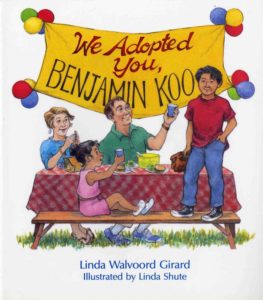 We Adopted You, Benjamin Koo, written by Linda Walvoord Girard, illustrated by Linda Shute. This is written from the perspective of a 9-year old Korean adoptee and is adoptee centric. It is a story of dealing with the complexities of adoption and having a new adoptee join the family. It talks about strategies to understand adoption loss, the meaning of family and seeking support from professionals. It addresses issues of racism, talents, goals and birth culture. It does use a bit of outdated adoption language.
We Adopted You, Benjamin Koo, written by Linda Walvoord Girard, illustrated by Linda Shute. This is written from the perspective of a 9-year old Korean adoptee and is adoptee centric. It is a story of dealing with the complexities of adoption and having a new adoptee join the family. It talks about strategies to understand adoption loss, the meaning of family and seeking support from professionals. It addresses issues of racism, talents, goals and birth culture. It does use a bit of outdated adoption language.
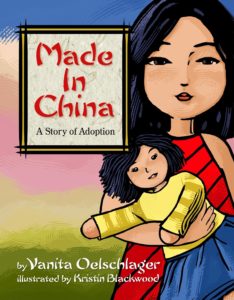 Made in China, written by Vanita Oelschlager, illustrated by Kristin Blackwood – This is a short, simple book written in poem form a about a young adoptee whose sister makes fun of her for being made in china like other objects around her house. Her dad tries to comfort her, but uses language we don’t like that suggests that the adoptees role is to bring joy to her family and that she was born to be loved by them. It does mention the adoptees birth culture and birth family.
Made in China, written by Vanita Oelschlager, illustrated by Kristin Blackwood – This is a short, simple book written in poem form a about a young adoptee whose sister makes fun of her for being made in china like other objects around her house. Her dad tries to comfort her, but uses language we don’t like that suggests that the adoptees role is to bring joy to her family and that she was born to be loved by them. It does mention the adoptees birth culture and birth family.
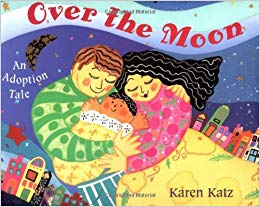 Over The Moon: an Adoption Tale written and illustrated by Karen Katz – This book is an AP centric account of a hopeful adoptive couple dreaming of their future child, traveling to their child’s birthplace, adopting their daughter, and her homecoming. It uses language about the child being “meant” to be in the APs family, which is language we don’t use. The illustrations re bright and cheerful. The book celebrates how excited the APs are to have their daughter in their family.
Over The Moon: an Adoption Tale written and illustrated by Karen Katz – This book is an AP centric account of a hopeful adoptive couple dreaming of their future child, traveling to their child’s birthplace, adopting their daughter, and her homecoming. It uses language about the child being “meant” to be in the APs family, which is language we don’t use. The illustrations re bright and cheerful. The book celebrates how excited the APs are to have their daughter in their family.
